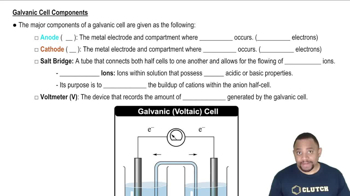Here are the essential concepts you must grasp in order to answer the question correctly.
Nernst Equation
The Nernst Equation relates the cell potential to the concentrations of the reactants and products in an electrochemical cell. It shows how the voltage of a cell changes with varying concentrations, allowing us to predict the effect of concentration changes on cell voltage. Specifically, it states that the cell potential increases with an increase in the concentration of reactants and decreases with an increase in the concentration of products.
Recommended video:
Electrochemical Cell
An electrochemical cell consists of two electrodes (anode and cathode) immersed in an electrolyte, where oxidation and reduction reactions occur. The cell voltage is determined by the difference in potential between the two electrodes, which is influenced by the concentration of ions in the electrolyte. In the case of a mercury battery, the concentration of KOH affects the availability of hydroxide ions, which can impact the overall cell reaction and voltage.
Recommended video:
Concentration and Cell Voltage Relationship
The relationship between concentration and cell voltage is crucial in electrochemistry. A tenfold change in the concentration of KOH will significantly affect the concentration of hydroxide ions in the electrolyte, which can shift the equilibrium of the half-reactions. This shift can lead to a measurable change in the cell voltage, as described by the Nernst Equation, highlighting the importance of concentration in determining the efficiency and output of electrochemical cells.
Recommended video:




